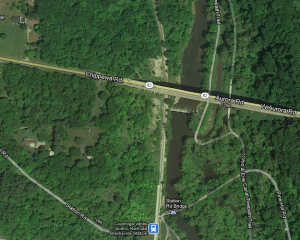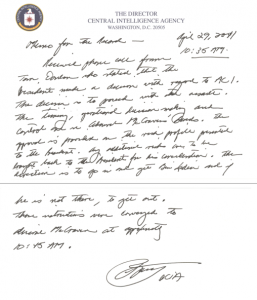Operational flexibility: This is a highly classified area. All I want to say is that there was “before” 9/11 and “after” 9/11. After 9/11 the gloves come off.
-Cofer Black, 9/11 Congressional Inquiry, September 26, 2002
When Cofer Black, the main author of the plan laid out in the September 17, 2001 Memorandum of Notification that appears to be at issue in the FOIA dispute between the CIA and White House and the ACLU (post 1, post 2, post 3, post 4, post 5), testified before the 9/11 Congressional Inquiry, he described the expanded operational flexibility CIA’s counterterrorism efforts gained after 9/11 by saying “the gloves come off.”
As this post shows, the legal means by which “the gloves come off” was the MON in question. Thus, rather than referring to the MON by its date, perhaps the best way for us to think of it is as the “Gloves Come Off MON.”
Before we get into what the MON did, here’s what the National Security Act, as amended, says such MONs are supposed to do. The NSA requires the President to notify congressional intelligence and appropriations committees (or, in rare cases, the Gang of Eight) of any covert operations he has authorized the CIA to conduct. Some important excerpts:
SEC. 503. [50 U.S.C. 413b] (a) The President may not authorize the conduct of a covert action by departments, agencies, or entities of the United States Government unless the President determines such an action is necessary to support identifiable foreign policy objectives of the United States and is important to the national security of the United States, which determination shall be set forth in a finding that shall meet each of the following conditions:
(1) Each finding shall be in writing, unless immediate action by the United States is required and time does not permit the preparation of a written finding, in which case a written record of the President’s decision shall be contemporaneously made and shall be reduced to a written finding as soon as possible but in no event more than 48 hours after the decision is made.
[snip]
(5) A finding may not authorize any action that would violate the Constitution or any statute of the United States.
[snip]
(d) The President shall ensure that the congressional intelligence committees, or, if applicable, the Members of Congress specified in subsection (c)(2) [the Gang of Eight], are notified of any significant change in a previously approved covert action, or any significant undertaking pursuant to a previously approved finding, in the same manner as findings are reported pursuant to subsection (c).
As used in this title, the term ‘‘covert action’’ means an activity or activities of the United States Government to influence political, economic, or military conditions abroad, where it is intended that the role of the United States Government will not be apparent or acknowledged publicly, but does not include—
(1) activities the primary purpose of which is to acquire intelligence, traditional counterintelligence activities, traditional activities to improve or maintain the operational security of United States Government programs, or administrative activities;
Basically, the MONs are supposed to provide an up-to-date written notice of all the potentially very embarrassing things the CIA is doing. And given that MONs cannot authorize unconstitutional or illegal (within the US) actions, it should impose some legal limits to covert operations.
Dick Cheney, in a 1989 speech complaining about Congressional overreach in foreign policy (Charlie Savage just posted this), described how this requirement to inform Congress of covert ops provided a way for Congress to oppose such actions by defunding any ongoing ones.
The 1980 law [requiring notice] did not challenge the President’s inherent constitutional authority to initiate covert actions. In fact, that law specifically denied any intention to require advance congressional approval for such actions.
[snip]
Any time Congress feels that an operation is unwise, it may step in to prohibit funds in the coming budget cycle from being used for that purpose. As a result, all operations of extended duration have the committees’ tacit support.
That’s the understanding of the limitations MONs might impose on Presidents that Cheney brought to discussions of the Gloves Come Off MON.
Bob Woodward provides an extensive discussion of what George Tenet and Cofer Black requested in this MON in Bush at War.
At the heart of the proposal was a recommendation that the president give what Tenet labeled “exceptional authorities” to the CIA to destroy al Qaeda in Afghanistan and the rest of the world. He wanted a broad intelligence order permitting the CIA to conduct covert operations without having to come back for formal approval for each specific operation. The current process involved too much time, lawyering, reviews and debate. The CIA needed new, robust authority to operate without restraint. Tenet also wanted encouragement from the president to take risks.
Another key component, he said, was to “use exceptional authorities to detain al Qaeda operatives worldwide.” That meant the CIA could use foreign intelligence services or other paid assets. Tenet and his senior deputies would be authorized to approve “snatch” operations abroad, truly exceptional power.
Tenet had brought a draft of a presidential intelligence order, called a finding, that would give the CIA power to use the full range of covert instruments, including deadly force. For more than two decades, the CIA had simply modified previous presidential findings to obtain its formal authority for counterterrorism. His new proposal, technically called a Memorandum of Notification, was presented as a modification to the worldwide counterterrorism intelligence finding signed by Ronald Reagan in 1986. As if symbolically erasing the recent past, it superseded five such memoranda signed by President Clinton.
Woodward describes other things included in Tenet’s request:
- Providing hundreds of millions to “heavily subsidize Arab liaison services,” effectively “buying” key services in Egypt, Jordan, and Algeria
- Equipping Predator drones with Hellfire missiles for lethal missions to take out top al Qaeda figures Read more →
 The bridge on 82 in this picture is the bridge a bunch of purported “anarchists” have just been arrested for threatening to blow up.
The bridge on 82 in this picture is the bridge a bunch of purported “anarchists” have just been arrested for threatening to blow up.

